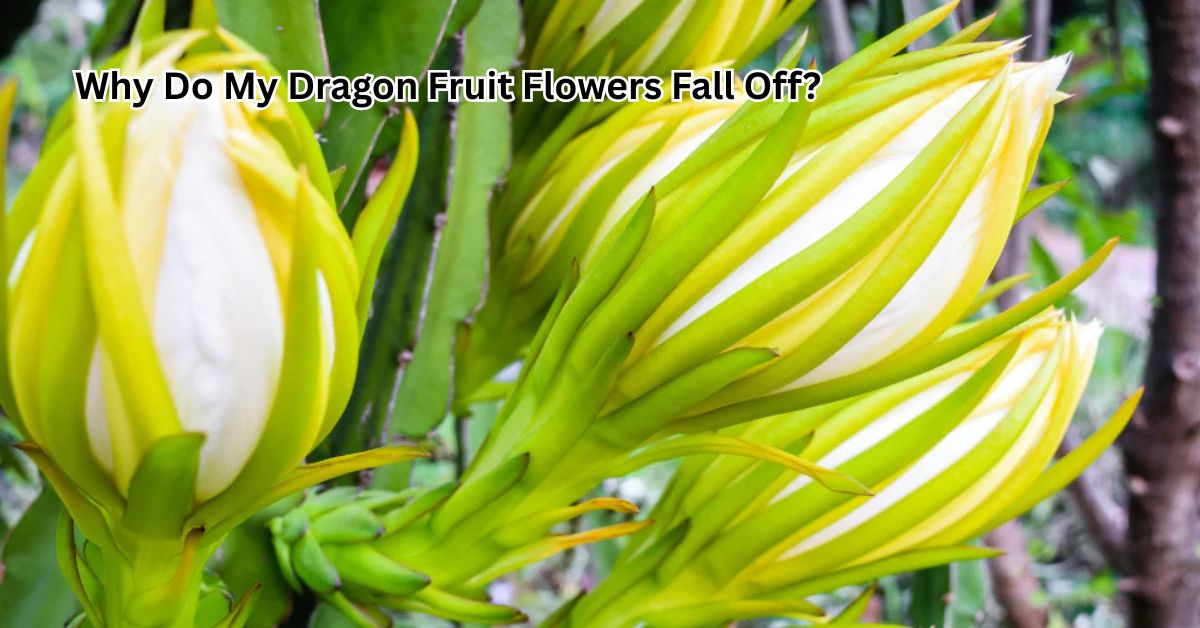
Dragon fruit, also called pitaya, is a bright and tasty fruit that grows on a cactus. People love it for its color, flavor, and health benefits. But many gardeners and farmers notice a problem—the flowers fall off before they can become fruit. If you’re asking, “Why do my dragon fruit flowers drop?” this article will help.
Let’s look at the reasons why this happens and how you can stop it to grow more dragon fruit.”
This version uses easier words and shorter sentences while keeping the same meaning. Let me know if you’d like any further changes!
Understanding Dragon Fruit Flowering
Before we talk about why flowers fall off, let’s see how dragon fruit flowers grow.
- Dragon fruit plants usually start flowering in late spring or summer.
- The flowers open at night and are pollinated by moths, bats, or by hand.
- If pollination works, the flower turns into fruit.
- If not, the flower dries up and drops.
Now, let’s find out why dragon fruit flowers may fall off.
Top Reasons Why Dragon Fruit Flowers Drop
1 : Poor Pollination
Dragon fruit flowers often need pollen from a different flower or plant to grow fruit. If they don’t get pollinated properly, the flowers will fall off.
Signs:
- Flowers bloom but dry up and drop the next day.
- No fruit starts to form after the flower falls.
Solution:
- Use a soft brush to pollinate the dragon fruit flowers by hand.
- Do this at night or early in the morning when the flowers are open.
- Plant different types of dragon fruit to help with pollination.
How to fix it:
- Use a soft brush to move pollen between flowers.
- Do this when the flowers are open (night or early morning).
- Grow different kinds of dragon fruit plants to help them pollinate each other.
2 : Harsh Weather Effects on Dragon Fruit
Dragon fruit grows best in warm, humid climates. Heavy rain, strong winds, or very hot/cold weather can harm its flowers.
Signs of Damage:
- Flowers fall off after heavy rain or extreme heat.
- Petals turn brown or start rotting.
How to Protect the Plant:
- Use a shade net in very hot weather.
- Shield the plant from strong winds and heavy rain.
- Make sure water drains well to prevent flooding.
3 : Nutrient Deficiency
When plants don’t get enough important nutrients like potassium, phosphorus, or calcium, their flowers may become weak and fall off.
Signs to look for:
- Leaves turning yellow.
- Flowers are small and weak.
How to fix it:
- Use a balanced fertilizer with enough phosphorus and potassium.
- Add compost or organic material to make the soil healthier.
- Don’t use too much nitrogen, as it helps leaves grow but not flowers.
4 : Too Much or Too Little Water
Giving your plant too much or too little water can harm it and make the flowers fall off.
Signs of a Problem:
- Soft, rotting stems or roots (too much water).
- Dry, wrinkled stems (too little water).
How to Fix It:
- Water only when the top layer of soil feels dry.
- Make sure the pot or garden bed drains well.
- Avoid wetting the flowers when watering.
5 : Overwatering or Underwatering
Giving a plant too much or too little water can harm it and make its flowers fall off.
Symptoms:
- Soft stems or rotten roots (caused by too much water).
- Wrinkled, dry stems (underwatering).
Solution:
- Only water if the top soil is dry.
- Make sure water can flow out easily from pots or garden beds.
- Don’t pour water straight onto the flowers.
How to Prevent Flower Drop – Quick Tips
| Issue | Prevention Tip |
|---|---|
| Pollination | Hand-pollinate at night with a brush |
| Weather | Use shade nets and wind protection |
| Nutrition | Feed with phosphorus and potassium-rich fertilizer |
| Water | Water deeply but infrequently; ensure drainage |
| Pests | Monitor regularly and treat early |
Conclusion
It’s disappointing when dragon fruit flowers fall off, especially after waiting so long for them to bloom. But don’t worry—this happens to many growers, and it’s usually due to a few main reasons:
Poor pollination
Too much heat, wind, or rain
Overwatering or underwatering
Lack of the right nutrients
Pests or diseases
The good news is, you can fix most of these issues with some simple care. Here’s how:
Pollination : If bees aren’t around, try hand-pollinating the flowers at night with a small brush.
Weather Protection : Use shade cloth in hot weather and shield the plant from strong wind and heavy rain.
Watering & Feeding : Water deeply but not too often. Use a fertilizer with more phosphorus and potassium (not too much nitrogen).
Pest Control : Check for bugs like mealybugs and treat them early with natural sprays.
Dragon fruit plants need patience and care, but if you keep trying, you’ll get beautiful flowers and tasty fruit. Every problem (like falling flowers) is a chance to learn and improve. Watch your plant closely, take notes, and soon, you’ll grow dragon fruit like a pro!




